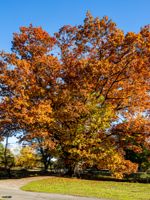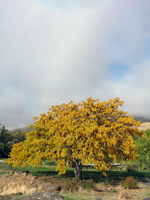Mon-Fri 9am - 5pm Mountain time
Northern Red Oak vs Thornless Honeylocust
Quercus rubra
Gleditsia triacanthos inermis
Northern Red Oak is a medium-sized deciduous tree. It is fast-growing (for an oak tree) and is used primarily in lawns, parks, golf courses, street-side plantings, and commercial areas. Northern Red Oak's fall color is spectacular.
In open spaces, it has a short, massive trunk and an extensive crown. In forests Northern Red Oak grows with a tall columnar bole and small rounded head.
We are one of the only nurseries growing this tree.
Check out some video of the spectacular fall colour on our Northern Red Oak seedlings just before harvest on our YouTube Channel.
Note: Most Oak species can be considered toxic for many animals.
Thornless Honey Locust makes an excellent shade tree with its lacy foliage and dappled shade. The leaves are honey-yellow, light and airy, providing interesting color and texture to your landscape. This variety is thornless, and the seeds and pods provide food for wildlife such as deer and squirrels.
The Thornless Honey Locust is tolerant of drought, various soil conditions, and even road salt.

